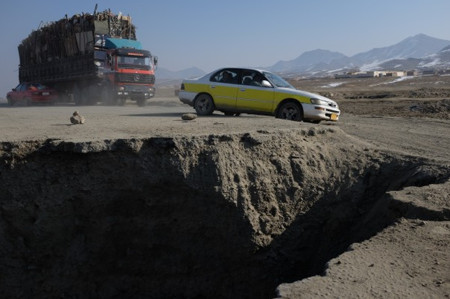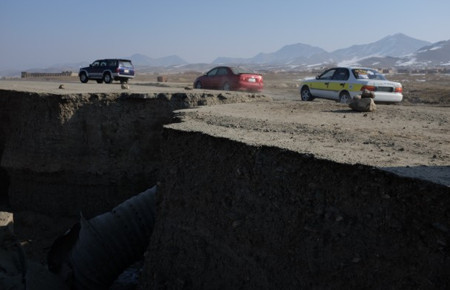By Kevin Sieff
SAYEDABAD, Afghanistan — They look like victims of an insurgent attack — their limbs in need of amputation, their skulls cracked — but the patients who pour daily into the Ghazni Provincial Hospital are casualties of another Afghan crisis.
They are motorists who drove on the road network built by the U.S. government and other Western donors — a $4 billion project that was once a symbol of promise in post-Taliban Afghanistan but is now falling apart.
Western officials say the Afghan government is unable to maintain even a fraction of the roads and highways constructed since 2001, when the country had less than 50 miles of paved roads. The deterioration has hurt commerce and slowed military operations. In many places, the roads once deemed the hallmark of America’s development effort have turned into death traps, full of cars careening into massive bomb-blast craters or sliding off crumbling pavement.
“There’s been nothing. No maintenance,” said a U.S. official who spoke on the condition of anonymity because he wasn’t authorized to discuss the issue publicly.
Since 2012, the United States has refused to fund the Afghan government’s road maintenance projects because it has no faith in the country’s ability to perform even simple tasks, such as dispatching a contractor to fill in a pothole or repaving a stretch of highway.
Despite those concerns, the U.S. government is still building new roads in Afghanistan, multimillion-dollar projects whose funds were allocated years ago.
The Afghans say they are doing some maintenance but claim the cutoff in U.S. funds has left them hamstrung.
“We don’t have enough money to work as they did,” said Mohammad Aref Raiskhel, the director of maintenance at Afghanistan’s Ministry of Public Works. “I beg them to help us once again.”
Before the U.S. invasion in 2001, almost all of Afghanistan’s roads — mostly Soviet-built — had been destroyed by war and neglect. The new, U.S.-built highways seemed to be a godsend for this impoverished nation. But the projects became notorious for their exorbitant costs and poorly implemented contracts. Sometimes, money landed in the hands of the Taliban in exchange for a tacit cease-fire during road construction.
Now the rapid deterioration of the roads could come to symbolize a failure to preserve key gains.

Vehicles navigate a stretch of Highway One, damaged by a roadside bomb, in Sayed Abad, Afghanistan. The 300-mile road connects Kabul and Kandahar, two of the country’s most important cities. (Photo: Kevin Sieff/The Washington Post)
Some of the roughly 10,000 miles of roads and highways built by Western donors have been worn away by overuse. Others are shredded by hundreds of improvised explosive devices (IEDs) laid by insurgents. Not long ago, U.S. troops and contractors repaired them, but those resources are now gone.
“It’s very hard for us to justify to our leadership in Washington that we should be putting more funds into this unless there’s some type of response on the other side,” the U.S. official said.
On the 300-mile Highway One, which connects two of the country’s most important cities, Kabul and Kandahar, the number of fatal car crashes has soared as the road has deteriorated. Military operations, including urgent casualty evacuations, have been slowed by the crumbling highway.
“The road is a disaster. It causes obstacles and delays and countless casualties,” said a senior Afghan commander in eastern Afghanistan, who spoke on the condition of anonymity because he wasn’t authorized to discuss the matter publicly.
The problems are due in part to an insurgency that, 12 years into the war, is far stronger than the United States had anticipated.
In the past six months, one Afghan battalion unearthed 200 IEDs on a 12-mile stretch of Highway One. In many other cases, the bombs were not detected and wound up exploding, leaving truck-size holes in the asphalt. Few of those holes were adequately filled.
In the Sayedabad district of Wardak province, one blast crater is 15 feet wide and 25 feet deep, a crevice big enough to swallow an 18-wheeler. Three months after the explosion, there’s been no effort to repair it.
“If only they would repair the road, we would definitely have fewer casualties,” said Zia Gul, the director of public health in neighboring Ghazni.
Many officials worry that the U.S.-funded roads still under construction will fall into disrepair after they’re completed. One 60-mile road in eastern Afghanistan, between Khost and Paktia provinces, has cost almost $5 million per mile, largely because of the cost of providing security for construction workers. The last 15 miles are slated to be completed this year.
A key network
The United States almost immediately made road construction a top priority after the 2001 invasion — calling an effective network of highways and rural roads the key to both security and economic stability.
“Wherever the road ends, that’s where the Taliban starts,” said then-U.S. commander Lt. Gen. Karl Eikenberry in 2006.

The number of fatal car crashes on Highway One has soared as the road has deteriorated. (Photo: Kevin Sieff/The Washington Post)
The U.S. military and USAID funded more than $2 billion in roads — one of the largest American investments in Afghanistan. A host of foreign donors, particularly Germany, the World Bank and the Asian Development Bank, also poured billions into construction.
During the years of rapid construction, the donors’ conversations with the Afghan government about road maintenance were rare. “There was such an urgent need to build highways,” the U.S. official said. “Maintenance was not the issue at the time.”
Afghan officials assumed they would receive ongoing financial support to maintain the roads. U.S. officials say they likely would have provided such aid, if the Afghan authorities had proven competent. So far, U.S. efforts to build an Afghan Road Authority that would fund and implement maintenance have been largely ineffective, as tension between the two governments has risen.
“They are the ones who are incompetent. Look how long it’s taken them to build these roads — and how much they’ve cost,” Raiskhel said.
Now, U.S. officials say, the problem lies mostly with the Public Works Ministry, a notoriously troubled institution. The ministry has changed little since its formation under the Soviet-backed government in the 1970s, and it lacks the ability to procure contracts or implement its own projects, according to U.S. and other Western officials. Each year, half of its budget goes unspent because of mismanagement, according to U.S. officials.
The problems are most evident on Highway One, which runs through the country’s most embattled areas.
In the past, the U.S. Army would dispatch a platoon for days at a time to repair and reopen roads. The rapid American military withdrawal has taken away those resources.
Thanks to the lack of maintenance in the past two years, U.S. officials say the road has deteriorated roughly 40 percent.
“Things have gotten so much worse,” said Abdul Jamil, a taxi driver. “Now, if we drive too fast, everyone in the car dies.”
Afghan officials say they don’t have the resources to replicate the U.S. road maintenance they relied on for a decade.
Aside from the Afghan government’s institutional weaknesses, a lack of security poses an enormous challenge to would-be maintenance efforts. More than 200 workers were killed in the process of constructing the country’s road network over the last decade. In southern and eastern Afghanistan, any maintenance crew would inevitably become a target.
In eastern Nurestan province last fall, for example, the World Bank sent surveyors to analyze a possible road construction and maintenance project. Within weeks, the survey was shuttered after its employees were targeted by the Taliban.
Still, no one doubts the value of the country’s central highway network, deemed the “Ring Road,” which includes Highway One and connects 16 of Afghanistan’s 34 provinces. More than two-thirds of Afghans live within 30 miles of the road, according to U.S. officials.
Privately, U.S. officials have been pressuring the Afghan ministries to improve before pledging more funds. So far, that pressure appears to have yielded little.
“They’ve got to demonstrate that they can step up. . . . Funding is just not possible as things are,” the U.S. official said.
Last month, a Toyota Corolla carrying 15-year-old Kariumullah Amini and his family slammed into another vehicle on a stretch of Highway One destroyed by a Taliban attack. The drivable part of the road was so narrow that the cars collided head-on. Amini’s mother, father and brother were critically wounded.
“There are so many problems on the road,” Amini said. “Each day, it gets worse.”



